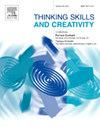Creative art-based pedagogies with autistic students: A systematic review on stakeholders' perspectives on its delivery and implementation in secondary mainstream schools
IF 4.5
2区 教育学
Q1 Social Sciences
引用次数: 0
Abstract
More than 70 % of autistic young people are educated in mainstream schools and some, similarly to their non-autistic peers, experience challenges in mainstream settings. Research suggests that the creative arts offer unique prospects in the education of autistic students. However, such research primarily explores the creative arts in a therapeutic or interventional context; little research has considered creative arts’ use as a pedagogical tool in mainstream secondary school classrooms with autistic students. The current narrative systematic review aims to synthesise empirical evidence concerning: (a) how creative arts-based pedagogy (CABP) is theorised, (b) creative arts-based pedagogies implementation and delivery with autistic secondary school students and (c) research gaps in the field. Identified through thematic analysis, findings indicate that creative arts-based pedagogy was perceived with greater positivity than negativity, yet a greater number of disabling factors were identified than enabling factors. The only paper to explicitly discuss a gap in research within the extracted data was Kehl (2021). However, in the concluding sections not under analysis in line with this study's data extraction approach, further gaps in research were identified. Further research is required to establish enabling factors that can help increase the effectiveness of CABP delivery and implementation in secondary educational settings with autistic students.
自闭症学生的创意艺术教学法:持份者对其在中学主流学校的推行和实施的观点的系统回顾
70%以上的自闭症年轻人在主流学校接受教育,其中一些人与非自闭症同龄人一样,在主流环境中面临挑战。研究表明,创造性艺术为自闭症学生的教育提供了独特的前景。然而,这些研究主要是在治疗或干预的背景下探索创造性艺术;很少有研究认为创造性艺术在主流中学自闭症学生的课堂上被用作教学工具。当前的叙述性系统综述旨在综合以下方面的经验证据:(a)创意艺术教学法(CABP)是如何理论化的,(b)创意艺术教学法在自闭症中学生中的实施和交付,以及(c)该领域的研究空白。通过主题分析,研究结果表明,创造性艺术为基础的教学法被认为具有更大的积极性,而不是消极性,但发现的不利因素多于有利因素。唯一一篇明确讨论提取数据中研究差距的论文是Kehl(2021)。然而,在结论部分没有根据本研究的数据提取方法进行分析,进一步的研究差距被确定。需要进一步的研究来确定能够帮助提高在中等教育环境中对自闭症学生实施CABP的有效性的有利因素。
本文章由计算机程序翻译,如有差异,请以英文原文为准。
求助全文
约1分钟内获得全文
求助全文
来源期刊

Thinking Skills and Creativity
EDUCATION & EDUCATIONAL RESEARCH-
CiteScore
6.40
自引率
16.20%
发文量
172
审稿时长
76 days
期刊介绍:
Thinking Skills and Creativity is a new journal providing a peer-reviewed forum for communication and debate for the community of researchers interested in teaching for thinking and creativity. Papers may represent a variety of theoretical perspectives and methodological approaches and may relate to any age level in a diversity of settings: formal and informal, education and work-based.
 求助内容:
求助内容: 应助结果提醒方式:
应助结果提醒方式:


